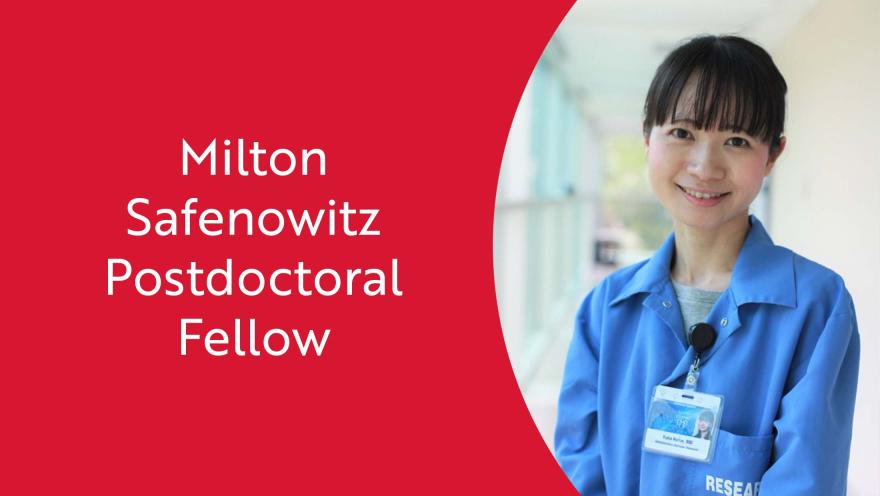The ALS Association has pledged to do whatever it takes to make ALS a livable disease, which means longer lives for people living with ALS, greater quality of life for people living with the disease and ultimately the prevention of ALS altogether. Researchers like our 2020 Milton Safenowitz Postdoctoral Fellowship Program recipients are playing an important role in helping to make this happen.
The Milton Safenowitz Postdoctoral Fellowship Program continues to support young scientists and is the only program of its kind specifically funding early ALS postdoctoral fellows eagerly searching for a cure. Founded in memory of Mr. Safenowitz by the Safenowitz family through The ALS Association Greater New York Chapter, this unique program encourages young scientists to enter and, importantly, to remain in the ALS field.
More than 75% of the postdoctoral fellows the Association funds go on to start their own labs to continue studying ALS and mentor other young ALS researchers. The rest of the Safenowitz fellowship program graduates typically go on to careers in the biomedical industry, nonprofits, and medical writing, with many still staying in the ALS space.
This year, we were proud to support eight new postdoctoral fellows out of a highly competitive applicant pool, two of which were made possible through funds provided by The ALS Association Oregon and SW Washington Chapter. We are excited to highlight each of them on our blog, their dedication and unique contributions to ALS research, as well as their interests outside of the lab.
In our final spotlight, we talked with Dr. Yuka Koike, postdoctoral fellow working under her mentor, Dr. Leonard Petrucelli in the Petrucelli lab at Mayo Clinic Jacksonville, to learn more about her and her ALS research focused on revealing how TDP-43 mediated RNA dysfunction contributes to ALS/FTD disease.
Can you briefly describe your academic background?
I received my Bachelor of Medicine, followed by training in neurology. Then I received my Ph.D. in the field of neuroscience.
It is said that every 90 minutes, someone is diagnosed with ALS and every 90 minutes someone dies from the disease. Time is not on the side of those who are diagnosed, and no matter what issues we are all currently facing in the world, ALS won’t stop, so neither will we. What are you doing to address the urgency our ALS community is feeling?
Even in the COVID-19 pandemic, I and the members of Petrucelli lab have continued to work on studying the pathogenesis of ALS without stopping in order to find early diagnostic markers and appropriate therapeutic targets.
What are the goals of your funded research project?
My long-term objectives are to reveal how TDP-43 mediated RNA dysfunction contributes to ALS/FTD disease pathogenesis, refine disease pathways, and identify novel therapeutic targets. Recent studies demonstrate that TDP-43 regulates the splicing of stathmin-2 (STMN2), which encodes a protein associated with microtubule dynamics. Indeed, in central nervous system tissues from ALS/FTD patients, our lab members demonstrated the aberrant accumulation of a mis-spliced STMN2 RNA and a reduction of full-length STMN2 transcripts (Prudencio, et al, J Clin Invest, 2020). Given that STMN2 is critical for neuronal function and survival, I hypothesize that the reduced STMN2 expression, mediated by loss of TDP-43 function, has a critical impact on neurodegeneration in ALS/FTD pathogenesis, and try to elucidate the hypothesis.
Why did you decide to study ALS over other diseases?
Before proceeding to neuroscience research, I have been involved in diagnosis and supportive treatment for many ALS patients as one neurologist. In that experience, I came to have a sincere desire to clarify the essential pathogenesis and to find a fundamental therapy for this disease.
What do you like most about working in the ALS research field?
The patients with ALS and their families are very interested in the progress of this research field. I think our research and dissemination of the results may give them hope.
How might your work impact the ALS community?
My research proposal has a great promise of elucidating the molecular mechanism leading to neurodegeneration in models with underlying TDP-43 proteinopathy. Thus, the detailed analyses of the impacts of STMN2 downregulation could help verify whether STMN2 is useful as a novel therapeutic target in ALS/FTD.
Where can people get more details about your research project?
More information about neuroscience department of Mayo Clinic Florida can be found here.
It is often said that ALS is one of the most complex diseases to understand. Yet, you go to work every day to tackle the challenges of your research. What gives you hope that there will someday be a world without ALS?
Many researchers around the world continue to actively work to elucidate the disease. I believe that the elucidation of the pathogenesis will bring about an era in which ALS patients around the world can get fundamental therapies.
What do you like to do when you aren’t in the lab?
I can't go so many places now because of COVID-19, but I enjoy walking and shopping outside of the lab.
Is there anything else you’d like to add?
I would like to thank The ALS Association and the Safenowitz family for making this fellowship program possible and investing in my research.
Stay up to date with the latest ALS research news by subscribing to our monthly newsletter, Research Matters. To learn more about the research we fund, visit als.org HERE.


Join the conversation. Please comment below.